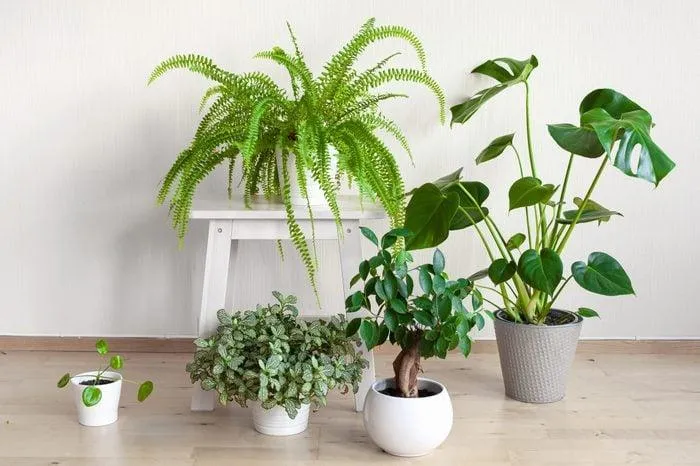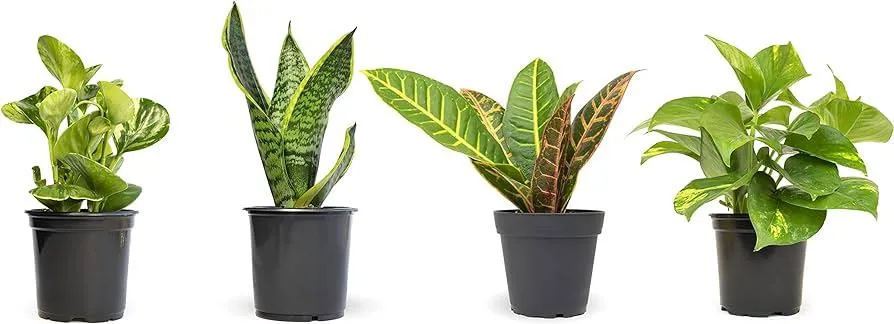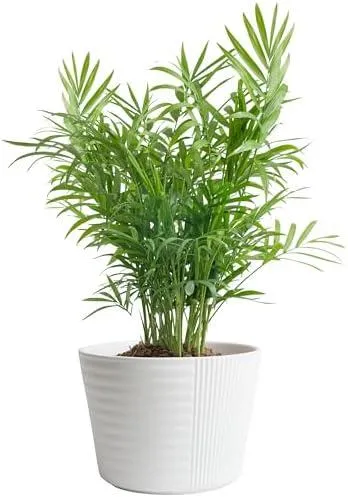The Best Unique Plants to Grow Indoors
If you’re looking for plants to add some visual interest to your home but want options beyond the typical pothos or spider plant, indoor plant parenting offers a world of unusual plants just waiting to be discovered. From my experience tending to over 20 different houseplants, growing unique plants indoors can be hugely rewarding. In this article, I’ll cover some of the coolest and most distinctive indoor plant varieties and provide tips for caring for each to help you select plants that suit your style and environment.
Air Plants (Tillandsia)
Air plants, also known as tillandsia, are some of the most unique and low-maintenance indoor plants you can grow. As epiphytes, they don’t require soil – just occasional water and occasional fertilizer. Their unusual shapes and textures make them a real focal point. I keep several varieties of air plants mounted in hanging glass terrariums and woven into artwork around my home. Due to their soilless nature, air plants are great for locations where traditional potted plants won’t work, like above sinks. To care for tillandsia, simply mist them with water a few times per week and fertilize monthly.
String of Pearls (Senecio rowleyanus)
With its delicate cascading strands of rounded green or ivory beads, string of pearls is one of the coolest succulents for trailing over shelves and down walls. I keep a string of pearls hanging in a south-facing window, where it’s grown nearly 3 feet long. This unique indoor plant thrives in dry, bright conditions and only needs water when the pearls start to look shrunken. Its flowing form is truly one-of-a-kind among houseplants.
Jelly Bean Plant (Sedum rubrotinctum)
Looking like a string of vibrantly colored jelly beans, the jelly bean plant adds an unusually bright pop of color. I keep a pot of jelly bean plant on my kitchen windowsill, where it receives lots of morning sunlight. It has thrived there for over a year, requiring only occasional watering. Sun stress brings out jewel tones of red, pink, and orange on the fleshy leaves. Though less vigorous a trailers than string of pearls, jelly bean plant is another unique succulent option.
Peperomia
Peperomias come in a dazzling array of forms and often have unusual markings or textures. Some peperomia varieties like watermelon, rosso, and ripple have ribbed, bumpy, or veined leaves unlike any other houseplant. Due to their varied growth habits—trailing, upright bushes, or crawling along the ground—peperomias add loads of visual interest. They thrive in medium to low light and make great beginner plants. Peperomias are low-maintenance as long as they receive moderated water. I’ve had great luck with peperomias thriving on my kitchen table under artificial lights.

Calathea
With their intricately patterned, almost artwork-like leaves, calatheas are one of the showiest plant families for indoor gardens. Due to their high moisture needs, calatheas can be tricky to care for, but the reward is leaves splashed with shades of green, pink, purple, and white. When I first got a calathea makoyana with ruffled purple backs to its leaves, I was stunned by its beauty. They love humidity, so I keep mine on a pebble tray. On the other hand, it’s taken lots of trial and error to find the right watering rhythm for my calatheas. Their dramatic appearances make calathea well worth the effort.
Exotic Cacti and Succulents
Beyond basic houseplant cacti like holiday cactus, you can find all sorts of unusual cacti and succulents suited to indoor growing. Some that catch my eye include greenovia, astrophytum, living stones, echeveria, and lithops “living stones.” With their spiny pads, pebbled skins, or bizarre shapes, exotic cacti have a truly alien appearance. I starting amassing a collection of succulents in terra cotta pots on my sunny front porch. Though many store-bought succulents are overlooked due to their size, their intricate small-scale forms are worthy of appreciation. With neglect-resistant care, unconventional succulents are perfect for plant lovers seeking something truly one-of-a-kind.
Staghorn Fern
No collection of bizarre indoor plants would be complete without staghorn fern. With its curvy woody fronds resembling deer antlers, staghorn fern has a prehistoric look like no other houseplant. A few years ago, I mounted a staghorn fern plaque on a wall in my kitchen near the sink. It provides interest any time I’m cooking or doing dishes. Staghorn ferns appreciate high humidity and don’t mind occasional collected rainwater or moisture from a pebble tray. Their ability to grow on walls adds installation flexibility. A unique landscaping element for any room.
Carnivorous Plants
For plant parents with a taste for the macabre, carnivorous plants like venus flytraps, pitcher plants, and sundews make gruesome yet fascinating houseplants. who doesn’t feel a chill seeing a venus flytrap snap its “jaws”? I started with a small sundew in a terrarium but now have over a dozen carnivorous species of various sizes. They love high-humidity environments and require purified or rainwater. Despite their frightening reputation, carnivorous plants are quite passive—you’ll rarely see them catch bugs. Their bizarre trapping mechanisms, however, are staples of strange plant collections. With a bit of effort, carnivorous beauties can thrive on indoors.
Resurrection Plants
Perhaps no other plant encapsulates the magic of unique houseplants quite like resurrection plants. Able to seemingly rise from the dead when rehydrated, resurrection plants like selaginella lepidophylla collapse into a desiccated grey ball when dry but bounce back after watering. I bought my first resurrection plant several years ago not fully believing its purported abilities. But sure enough – it shriveled and then revived on my kitchen windowsill! Resurrection plants prefer medium to low light and occasional drying-wetting cycles. Their zombie-like qualities make them hugely fun to own and show off to friends.

Other Options
Beyond these highlighted unique indoor plants, a wealth of other possibilities exists. Orchids like jewel, moth, and ghost orchids have ethereal blooms. Bromeliads come in captivating forms. Fragrant plants like ginger, stepped orchid, or cloves offer aromas indoors. Fiddle leaf figs and monsteras achieve giant statuesque sizes perfect for architectural placements. Carnivorous pitcher plants hatch various bug-trapping appendages. Bizarre hybrids and rarities appear in specialty plant shops. The possibilities are endless, so don’t afraid to get experimental!
Tips for Growing Unique Indoor Plants
While each unusual plant has its own specific needs, following some general tips will help most thrive inside:
- Provide adequate light. Most need medium to high light from an east or west window.
- Monitor water. Allow soil to partially dry between waterings and use purified water for finicky plants.
- Fertilize occasionally. Apply diluted water-soluble fertilizer during active growth periods.
- Choose the right pot. Terra cotta is generally best for drainage and aeration.
- Control pests. Isolate new acquisitions and inspect regularly for signs of bugs.
- Adjust conditions. Humidity trays, grow lights, and pebble trays aid plant health.
- Be patient. Some took me several tries to establish before they really took off indoors.
Growing unique indoor plants requires a bit of plant parent bravery beyond typical pothos. But with some attention to care tips, you’ll be rewarded with truly stand-out houseplants that surprise any visitor. While it may take some trial and error to find perfect matches for your space, experimental plant collecting is one of life’s simpler pleasures. I hope this guide has inspired you to try adding other weird and wonderful plants to your indoor jungles!
Top Indoor Plants for any Space
| Plant | Light Needs | Water Needs | Size | Notes |
|---|---|---|---|---|
| Pothos | Low | Let dry between waterings | Trailing vine up to 8 feet | Very hardy, easy to care for |
| Spider plant | Low-medium | Let dry between waterings | Up to 2 feet tall | Produces baby plants, very tolerant |
| Snake plant | Low | Infrequent watering | Up to 3 feet tall | Thrives with neglect, filters air |
| ZZ plant | Low-medium | Let dry between waterings | Up to 4 feet tall | Thick succulent-like leaves, very hardy |
| Peace lily | Medium | Let dry slightly between waterings | Up to 2 feet tall | White blooms, thrives in bathrooms |
FAQ
-
What are some unique plants I can grow indoors?
There are kinda a lot of cool plants you can raise inside your home. Spider plants are basically low maintenance and can withstand low light. Pothos vines are also pretty easy going. Chinese evergreens come in awesome colors and shapes. And peace lilies flower sometimes, which is amazing.
-
Is it hard to take care of indoor plants?
Caring for indoor plants isn’t too difficult, but you do gotta pay attention to them. You need to water them regularly, like once a week, to keep the soil moist. And put them in a spot with bright, indirect sunlight. At the same time, overwatering can basically drown your plant friends, so watch out! On the other hand, under watering will cause them to get crispy. So it takes some practice to get the care just right.

-
What soil is best for indoor plants?
Most indoor plants do well with a potting mix that drains well. Look for a soil labeled “potting mix” or “houseplant soil” at garden stores. These are made to dry out somewhat between waterings so you’re less likely to overwater. You can also add Perlite or coarse sand to regular potting soil to improve drainage. Peat moss based soils hold too much moisture in my experience.
-
How often should I water indoor plants?
It all depends on the plant variety and growing conditions. A good rule of thumb is to check the soil daily by sticking your finger about an inch down. When it’s dry, water thoroughly until it drains out the bottom. In the winter when there’s less light, you may only need to water every 10-14 days. But spider plants kinda like it a little drier than pothos. You gotta look at each plant’s needs. Is that fair?
-
What’s the best way to water indoor plants?
Pouring water into the soil until it comes out the drainage holes works well for most plants. Another method is bottom watering – set the whole pot in a container of water so it soaks up moisture through the drainage holes. This prevents mineral buildup on the leaves. You can also use a watering can with a long spout or a tablespoon to direct the water to the soil without getting the foliage wet. Whatever works for you!
-
How do I know if my indoor plant needs fertilizer?
Watch out for signs like stunted growth, yellowing leaves, or thin weak stems – those could mean your plant friends are hungry! Most indoor plants do well with a diluted liquid houseplant fertilizer once a month during the spring and summer. Read labels and follow instructions cause over fertilizing is basically asking for trouble. You can also fertilize with compost tea, kelp or worm castings. Live and learn, am I right?
-
What’s the best way to propagate indoor plants?
Lots of popular houseplants propagate quickly from stem or leaf cuttings. You take a snip, set it in soil or water, and new growth forms roots. Pothos, spider plants, philodendron, and more are cinch to multiply this way. Or for plants like succulents and peperomias, simply break off a leaf and set the broken edge on dry soil to grow a new plant. So get snippin’ and start your indoor jungle!

